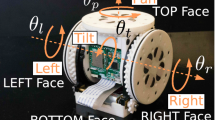Abstract
Metamorphic robots are modular robots that can reconfigure their shape. Such capability is desirable in tasks such as earthquake search and rescue and battlefield surveillance and scouting, where robots must go through unexpected situations and obstacles and perform tasks that are difficult for fixed-shape robots. The capabilities of the robots are determined by the design specification of their modules. In this paper, we present the design specification of a CONRO module, a small, self-sufficient and relatively homogeneous module that can be connected to other modules to form complex robots. These robots have not only the capability of changing their shape (intra-robot metamorphing) but also can split into smaller robots or merge with other robots to create a single larger robot (inter-robot metamorphing), i.e., CONRO robots can alter their shape and their size. Thus, heterogeneous robot teams can be built with homogeneous components. Furthermore, the CONRO robots can separate the reconfiguration stage from the locomotion stage, allowing the selection of configuration-dependent gaits. The locomotion and automatic inter-module docking capabilities of such robots were tested using tethered prototypes that can be reconfigured manually. We conclude the paper discussing the future work needed to fully realize the construction of these robots.
Similar content being viewed by others
References
Chen, I.-M. and Burdick, J. 1995. Determining task optimal modular robot assembly configurations. In Proc.IEEE Int.Conf.Robotics Automat., pp. 132–137.
Chirikjian, G. and Burdick, J. 1991. Kinematics of hyper-redundant robot locomotion with applications to grasping. In Proc.IEEE Int. Conf.Robotics Automat., pp. 720–725.
Farritor, S., Dubowsky, S., and Rutman, N. 1996. On the design of rapidly deployable field robotic systems. In ASME Design Engineering Technical Conference.
Fujita, M., Kitano, H., and Kageyama, K. 1998. Reconfigurable physical agents. In Proc.Int.Conf.Autonomous Agents, pp. 54–61.
Fukuda, T. and Kawauchi,Y. 1990. Cellular robotic system (CEBOT) as one of the realization of self-organizing intelligent universal manipulator. In Proc.IEEE Int.Conf.Robotics Automat., pp. 662–667.
Furuta, K. and Sampei, M. 1988. Path control of a three-dimensional linear motional mechanical system using laser. IEEE Trans.Industrial Electronics, 35(1):52–59.
Kotay, K., Rus, D., Vona, M., and McGray, C. 1998. The selfreconfiguring robotic molecule. In Proc.IEEE Int.Conf.Robotics Automat., pp. 424–431.
Murata, S., Kurokawa, H., and Kokaji, S. 1994. Self-assembling machine. In Proc.IEEE Int.Conf.Robotics Automat., pp. 441–448.
Murata, S., Kurokawa, H., Yoshida, E., Tomita, K., and Kokaji, S. 1998. A3-D self-reconfigurable structure. In Proc.IEEE Int.Conf. Robotics Automat., pp. 432–439.
Neville, B. and Sanderson, A. 1996. Tetrabot family tree: Modular synthesis of kinematic structures for parallel robotics. In Proc. IEEE Int.Symposium on Robotics Research, pp. 382–390.
Nilsson, M. 1998. Why snake robots need torsion-free joints and how to design them. In Proc.IEEE Int.Conf.Robotics Automat., pp. 412–417.
Paap, K., Dehlwisch, M., and Klaassen, B. 1996. GMD-Snake: A semiautonomous snake-like robot. Distributed Autonomous Robotic Systems 2, Springer-Verlag: Tokio.
Pamecha, A., Chiang, C.-J., Stein, D., and Chirikjian, G. 1996. Design and implementation of metamorphic robots. In Proc.1996 ASME Design Engineering Tech.Conf.and Comput.in Engineering Conf., pp. 1–10.
Pamecha, A., Ebert-Uphoff, I., and Chirikjian, G. 1997. Useful metrics for modular robot motion planning. IEEE Trans.Robotics Automat., 13(4):510–521.
Paredis, C. and Khosla, P. 1995. Design of modular fault tolerant manipulators. In Proc.First Workshop Algorithmic Foundations of Robotics, pp. 371–383.
Paul, R. 1981. Robot Manipulators: Mathematics, Programming and Control, MIT Press: Cambridge, MA.
Poi, G., Scarabeo, C., and Allota, B. 1998. Traveling wave locomotion hyper-redundant mobile robot. In Proc.IEEE Int.Conf. Robotics Automat., pp. 418–423.
Schonlau, W.J. 1999. MMS: A modular robotic system and model based control architecture. In Proc.1999 SPIE Conf.on Sensor Fusion and Decentralized Control in Robotic Systems II, pp. 289–296.
Will, P. and Grossman, D. 1975. An experimental system for computer controlled mechanical assembly. IEEE Trans.Computers, C-24(9):879–888.
Yim, M. 1993. A reconfigurable modular robot with multiple modes of locomotion. In Proc.JSME Conference on Advanced Mechatronics.
Yim, M. 1994. Locomotion with a unit-modular reconfigurable robot. PhD Thesis, Stanford University Dept. of Mechanical Engineering.
Yoshida, E., Murata, S., Tomita, K., Kurokawa, H., and Kokaji, S. 1997. Distributed formation control of a modular mechanical system. In Proc.Int.Conf.Intelligent Robots and Systems, pp. 1090–1097.
Author information
Authors and Affiliations
Rights and permissions
About this article
Cite this article
Castano, A., Shen, WM. & Will, P. CONRO: Towards Deployable Robots with Inter-Robots Metamorphic Capabilities. Autonomous Robots 8, 309–324 (2000). https://doi.org/10.1023/A:1008985810481
Issue Date:
DOI: https://doi.org/10.1023/A:1008985810481




